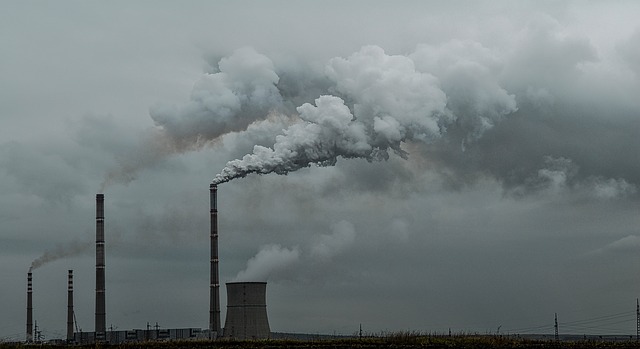Follow me:

Date posted: June 16th 2017
Book Title: Merchants of Doubt (continued)
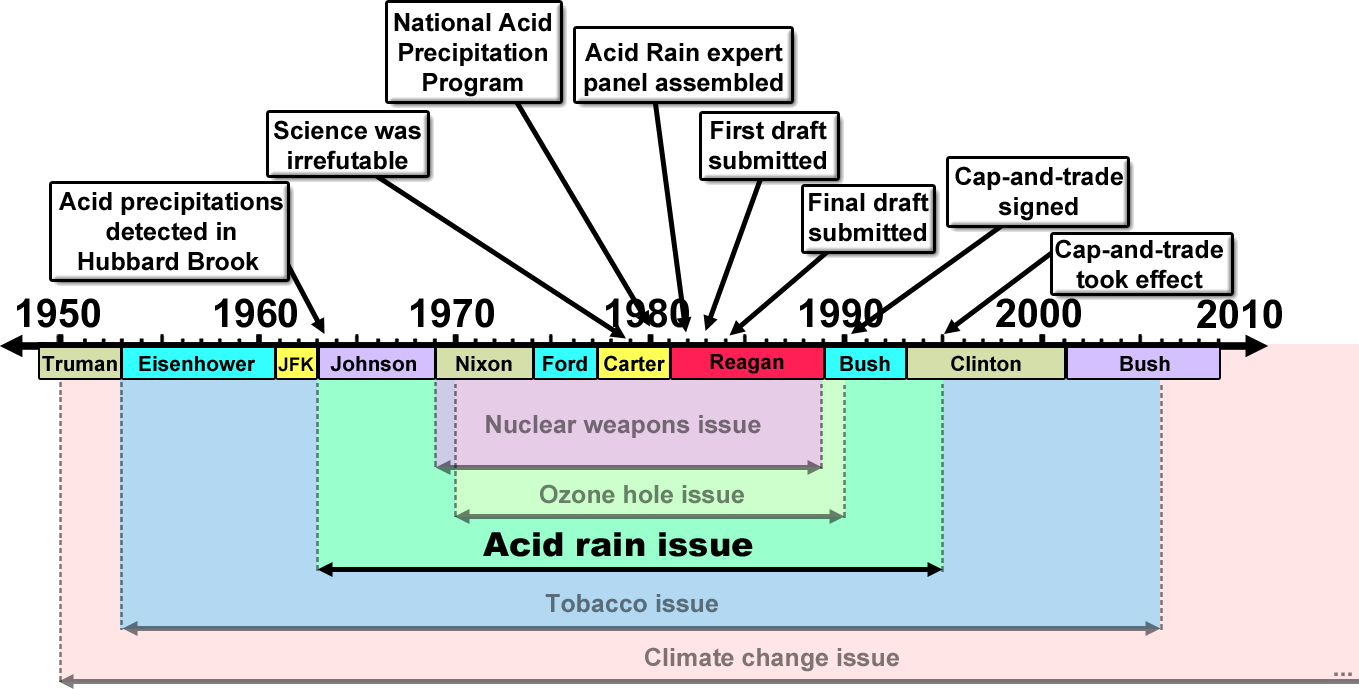
Timeline of the most relevant events from the acid rain issue
Image under Creative Commons Attribution-ShareAlike 4.0 International license via www.chasanabria.com
This story started rather quietly in 1963 when a group of scientist realized that acidic rain was falling in Hubbard Brook—a closely monitored forest area used to understand many aspects of its ecosystem1. Hubbard Brook was called an “experimental forest” (as oxymoronic as that sounds), and the detection of acid rain in this particular place was rather a strange finding since it was hundreds of miles away from industrialized areas. The question was, why would it develop sulfurous compounds (normally associated with pollution and smoke) if it was 100 miles from Boston and 300 miles from New York? It was a perfect mystery for a group of curious scientists, and over the following decade they realized these acidic compounds were coming from the tall smoke stacks of nearby cities.
-
Such as tree growth, nutrient variation, water flow, animal population, etc.↩
-
Which identifies unique patterns in the atomic mass variations (isotopes) of the acid rain, and matches them with the patterns of the possible sources↩
-
This is a name you want to remember, so I’ll keep calling him by his name↩
-
An organization that even in 2009 published an article entitled “five reasons why the EPA should not attempt to deal with global warming”↩
-
Soil scientist↩
-
In quotations because it didn’t really solve the problem↩
-
Fuck this guy... seriously↩
-
God damn it!↩
-
Despite being officially submitted in April↩
-
A very unstable form of oxygen with three atoms per molecule instead of two↩
-
SST stands for supersonic transport↩
-
Who would later get the Nobel prize for this work, and who also was part of the acid rain panel↩
-
I wonder why...↩
-
All of them strong advocates for “free market” and most of them received large amounts of money from corporations like General Motors, Mobil Oil, and Chase Manhattan↩
-
Science motherfucker!↩
The explanation was rather simple. The height of these smokestacks allowed the sulfur and nitrogen emissions from utility companies and car factories to travel large distances because of wind currents. This would later mix with rain and snow to produce acidic precipitations which had an impact on the wildlife and the soil quality. Soon the scientists realized it was happening all across the midwest—and America was not the only one. Acid rain was also causing a forest growth decline in Canada, and fish were dying in acidic lakes and rivers in Norway. The evidence was adding up fast!
A few years later acid rain started getting some public recognition with some skeptics naturally pushing back. They claimed the science was too uncertain, and that the acidity may not be man‑made. Instead, they claimed it may be coming from volcanoes. Good point. To answer this question, scientists did a complex analysis called ‘fingerprinting’2, showing that it was definitely man‑made. By 1979 the science was irrefutable: burning of fossil fuels (especially those whose emissions came out of tall smokestacks) was the cause of acid rain, and it was stripping the soils off their nutrients.
At this point, president Jimmy Carter kicking ass and taking names. Regarding acid rain, he made a bunch of changes and signed international agreements to reduce the sulfur emissions. Jimmy also started the National Acid Precipitation Assessment Program in 1980 which would monitor the emissions for the next 10 years. But then... Reagan took office…
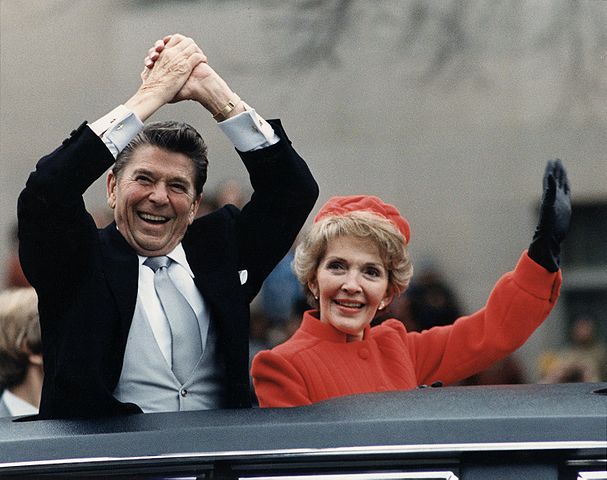
Ronald Reagan and Nancy Reagan waving from the limousine during the Inaugural Parade in Washington, D.C. on Inauguration Day, 1981.
Image under Public Domain via Wikimedia Commons
In reality the solution to acid rain was simple: since the private enterprise will never do anything about this (because they only care about profit and we live in a free‑market economy), government intervention was necessary. In other words we needed regulation… But this was clearly not happening with Reagan in the White House.
We learned from the tobacco story that uncertainty in the science was the easiest way out of regulation. We also learned from the the nuclear weapon story that putting a team of experts together was a perfect way to expose uncertainty. So in 1982 the White House called for a team of Acid Rain experts to be put together. The team was picked by no other than Bill Nierenberg (Asshole # 3) who just so happened to be part of Reagan’s transition team.
No one can deny that Asshole # 3 was a brilliant guy—of very strong opinions and fiercely competitive. Some of his colleagues would later point out jokingly that “he was sometimes in error, but never in doubt”. In all fairness, he did gather a pretty decent team of experts, including the guy who later won the nobel prize for noticing that CFCs were depleting the ozone layer, and the guy who detected the acid rain in the first place.
The panel was looking pretty good, despite the whitehouse rejecting some excellent candidates, but the Reagan administration was obviously not going to gamble with this touchy subject. They were not going to let those “left‑wing” scientists bully them into regulation, right? No. Their insurance on this issue was adding a panel member of their own… his name: Fred fucking Singer (or as I classified him at the beginning: the biggest asshole)3.
Fred Singer was closely affiliated with the Heritage Foundation4, and he was a master at exploiting doubt. His specialty was to find something that was not 100% certain (which in reality is not too hard to do), and highlight every sliver of doubt to the point that any efforts to initiate a solution would seem like a waste of money and resources. His go‑to phrase was “there is no need for government intervention”... on anything...sulfide emission, tobacco smoke, carbon dioxide, none!
Singer was a rocket scientist. Nothing to do with the environment and therefore no need to be in the acid rain panel whatsoever. But he was the ultimate merchant of doubt, and the White House knew it. Throughout the years he would use every weapon mentioned here, and he actually crafted a weapon of his own. A weapon that I call Singer’s weapon: promoting inaction… It consisted on showing that it is always cheaper and easier NOT to invest in a solution. This became Singer’s rapier.
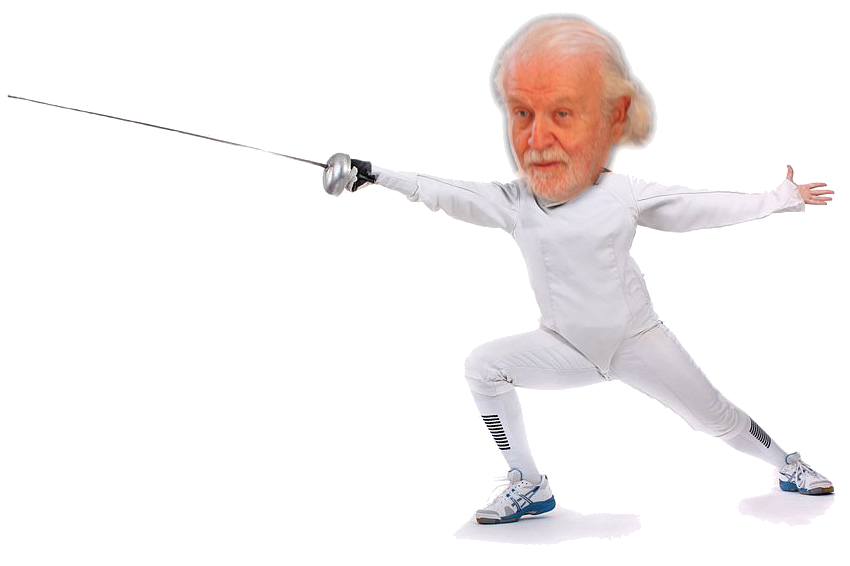
The ultimate merchant of doubt blandishing his weapon
Image slightly modified from its original version by Dako99 under Creative Commons license BY-SA 3.0 via Wikimedia Commons
So, in January of 1983, the Acid Rain panel started working on their report. They were supposed to submit a ‘first draft’ to the White House by June, and they did. This first draft came back from the White House with two of the most important paragraphs crossed out. The White House also demanded a change of tone: instead of starting with the problem, they wanted the report to start with the fact that the solution was partially being implemented.
Allow me to express what was really happening: you see, I’m pretty sure the Reagan White House had already made up its mind—there would be no regulation. The problem is that this report HAD to be published eventually, so they needed for it to look like acid rain wasn’t a big deal so people wouldn’t disagree with the lack of regulation. That’s why they kept asking for things to be less alarming and that’s why they put Fred fucking Singer on the panel.
Writing the second draft was a very uncomfortable situation. Singer was constantly trying whatever he could to inject his doubt into the report while the rest of the experts kept brushing him off. But this guy was not going anywhere, even Asshole # 3 thought he was being a little too pushy. In the end, Singer wrote an entire chapter filled with sentences like “scientifically we are not certain…”, or “control technologies are still costly and unreliable”. The panel (obviously) rejected his “chapter” and told him that if he really wanted to include this load of crap, he would have to add it as an appendix (in an attempt to get him to shut up). The problem of giving this mother fucker his own appendix, was that the rest of the authors didn’t have to critique it, which gave Singer the freedom to do whatever he wanted with that. So he did, and in it he stressed the fact that doing nothing was the cheapest option.
He used Weapon 3 (cherry picking), to show how expensive the solution was, but obviously NOT showing how expensive the problem could be. He used Weapon 1 (be a magician) by directing the argument towards car emissions, and how these would be tremendously expensive to implement. Which is true, but it is just a distraction from the larger problem: tall smokestacks—which would NOT be as tremendously expensive to implement. He even tried to use Weapon 6 (find a weak point and blow it out of proportion), by saying that it acid rain is not so bad because soils are naturally acidic. This is true, but he never followed up with: how acidic? The answer: much less acidic than acid rain.
As you can see this guy was a serious piece of shit. The only weapon that he didn’t use directly (in this case) was Weapon 2 (denial), which is only logical since he was part of a panel of experts, and denial would not have looked very good. But what pisses me off the most is that he was no expert! He was a rocket scientist; not a chemist, a meteorologist, or a pedologist5. Besides, he was forced into the panel by the White House7. Either way, the “final” report (with Singer’s appendix) was sent to the White house in April 1984, and I’m not sure if the members of congress read it, but around that same time congress rejected the joint pollution control program that was to be implemented by both Canada and the US… 8
It turned out this “final” report was actually NOT the one that got published later. Asshole # 3 said that changes were still being implemented up until July9, and the report wasn’t made public until August. The whole thing seemed very shady, especially because most of these changes were done without the panel’s consent. The record later showed that it was Asshole # 3 and Fred fucking Singer going back and forth moving paragraphs around in order to soften the message.
When the panel found out about this they were pissed. But it didn’t matter anymore. The damage was done, and the Reagan administration from then on would say the problem was too expensive to fix and that “we don’t know what is causing it” despite twenty‑one years of scientific studies explaining its causes and its dangers. All thanks to the doubt that Fred fucking Singer planted in this report.
It took six years, and a new administration, for the government to do something about this issue. The “solution”6 was cap‑and‑trade. A program implemented by George H W Bush which reduced the sulfur emissions by 54% with a total cost of 8 billion dollars but an estimated benefit of 100 billion dollars.
So, regulation won, right? Well, yes...but in the end Singer and his friends got what they wanted. Just like Asshole # 1 had done for the Tobacco industry, they delayed the regulation as much as they could by denying the severity of the problem...By planting doubt.
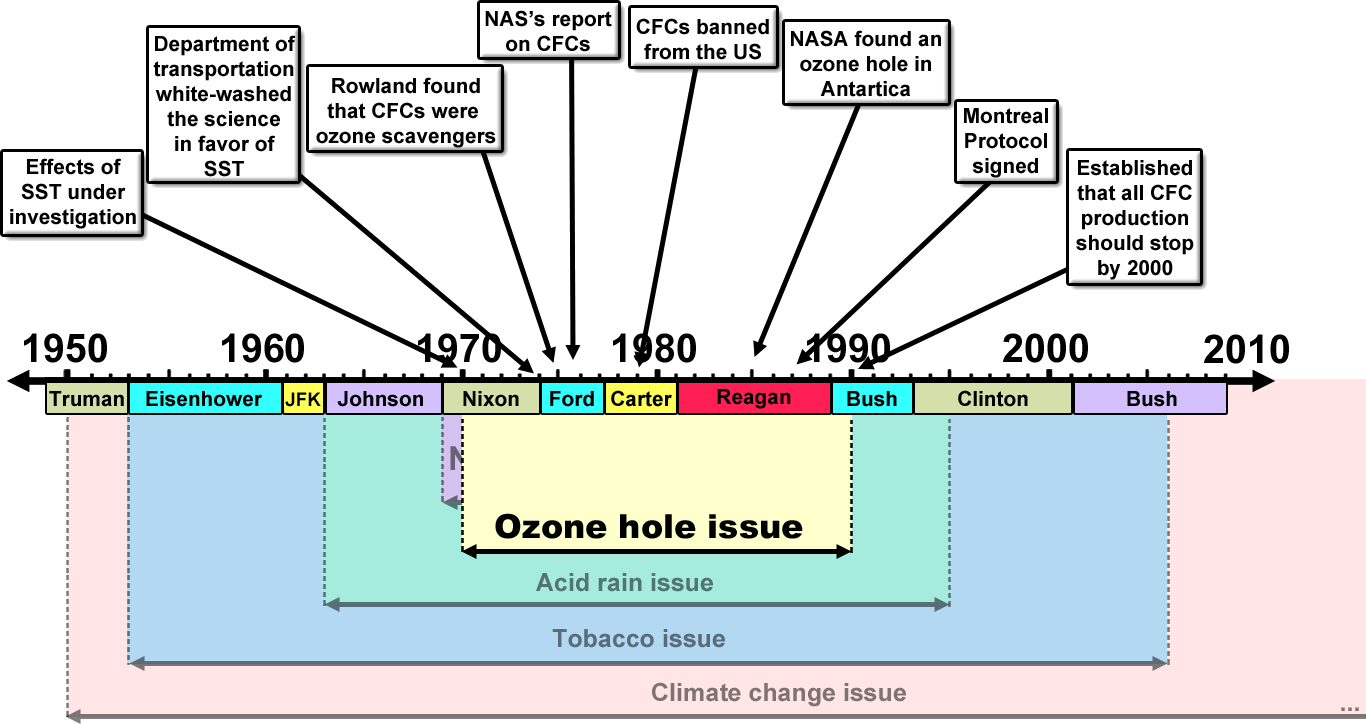
Timeline of the most relevant events from the ozone hole issue
Image under Creative Commons Attribution-ShareAlike 4.0 International license via www.chasanabria.com
There is a relatively thin layer of ozone10 that sits approximately between 15 to 40 kilometres (9 to 25 mi) above the Earth’s mean sea level. In 1913, we realized that this layer appears to absorb some of the ultraviolet (or UV) light that comes from the Sun. Which is a good thing, because this portion of UV that gets blocked is particularly harmful for all biological tissue. In more simple terms: the ozone layer is constantly protecting us from the harmful effects of small wavelength UV light—it would be a shame if it went away, right?
.png)
Levels of ozone at various altitudes, and its blocking effects on different types of ultraviolet radiation
Image under Public Domain via Wikimedia Commons
The fragileness of the ozone layer first came to be studied back when supersonic airplanes like the Concorde were being thought of as modes of transportation. In the year 1970, scientists (trying to get ahead of technology) started studying the possible effects of a large fleet of Supersonic Airplanes going back and forth between Europe and the US. They studied the dangers first, which were actually pretty alarming: a 1% reduction in the ozone would produce a 6% increase in skin cancer rates. Definitely not something to be tampered with. Then, the scientists calculated that a fleet of 500 supersonic airplanes going around could produce enough oxides of nitrogen to deplete the ozone layer by 10% (which would mean a 60% increase of skin cancer). This was no joking matter.
But even so, in 1975, the Department of Transportation came up with an executive report that whitewashed all of the science in the name of free‑market, and obviously the right‑wing media echoed it with headlines like “SST cleared on the Ozone”11. The scientists spoke up against it, trying to convince the people of the fragility of the ozone layer, but those who had seen Department of Transportation report had made up their mind already—and only looked at the scientists as alarmists. Some even disregarded the scientific claims as “unscientific nonsense”. Of course… as Mark Twain said, “It is easier to fool people than to convince them that they have been fooled”.

Concorde landing at Kansai International Airport in 1994
Image under Public Domain via Wikimedia Commons
In the end a large fleet of SST never happened, but the overall public opinion had already been tarnished. In their minds, the ozone layer was fine, and those who said otherwise were just trying to scare people. The problem came when new evidence was found about this issue. This time concerning chlorine compounds instead of oxides of nitrogen. In 1974, Sherwood Rowland12 found that the chlorofluorocarbons (or CFCs) used in aerosol cans were floating upwards (after they came out of the cans), and were being broken up by UV light. Once broken up, they became serious ozone scavengers—breaking down the ozone molecules permanently.
After this discovery the science started moving fast! The National Academy of Sciences realized the importance of this, and immediately set up a team to explore the issue in depth. As some of you could have guessed, the aerosol industry proceeded to do exactly what the Tobacco industry did, they created a research team of their own to defend their product. They called it the “Council on Atmospheric Science”, and its mission was the same as the Tobacco Research Committee: Fighting science with science (but obviously using the weapons of doubt).
They used Weapon 1 (being a magician) and distracted people by saying that the volcanoes also produce compounds of chlorine, and even went as far as setting up a scientific study on a volcano that was about to erupt in Alaska, but the results were never reported—other than saying that it was “inconclusive”13. They also used weapon 2 (denial) and said that CFCs couldn’t even go that high, and that we didn’t know if they were decomposing up there—nor that their byproducts attacked ozone. All bullshit. The National Academy of Science simply replied to this nonsense with their 1976 report, showing evidence of each one of the things aerosol industry was denying.
This issue was far more pressing than those we have seen in the previous stories, and the National Academy of Science had made such a strong case that most governmental agencies backed up the need for immediate regulation. A true success for science. By 1979 CFCs were banned from the US and NASA was told to keep track of the ozone layer—and to report any new science to congress every three months.
But the story doesn’t end there. In 1985 NASA found out that there was a huge ozone hole above Antarctica. This was extremely weird. Why only there? Was it caused by CFCs? Was it something else? Scientists love this kind of mysteries, so they rolled up their sleeves and got crackin’. Turns out it was the CFCs. Mainly because the rest of the world was still using them, and it appears they managed to travel through Polar Winds—which have certain ice crystals capable of accelerating the ozone break‑down.
Once again, science persisted. By 1987 several nations got together and signed the Montreal Protocol, which demanded 50% of CFC production to be cut over the next few years. They also agreed to meet regularly to discuss new evidence, and when they met for the second time in 1988, the evidence was so alarming that even DuPont® volunteered to stop all production of CFCs within 10 years. Two years later, in their third meeting in 1990, they concluded that all CFC production should cease by 2000.
This was indeed a successful instance in which science was taken seriously enough to implement regulation. But even after the Montreal Protocol, a few individuals were still trying to infiltrate doubt in the minds of the public. Especially those associated with conservative think tanks and institutions such as the Cato Institute, the American Enterprise Institute, the Heritage Foundation, the Marshall Institute and many others14.
Fred fucking Singer obviously was the biggest advocate against this regulation and he used all the weapons he could. Allow me to present his claims (things in quotations are things he said verbatim):
So according to Fred fucking Singer, it was better to just keep doing it the way we had been doing it, because the dangers were not real, and the solution was far too expensive and potentially dangerous. But how could he know this? Any replacement technology had not even been invented yet! It turns out he was full of shit once again; non‑CFC aerosols and refrigerants are now available, they are more energy efficient, and aren’t toxic, flammable, or corrosive as he claimed15.
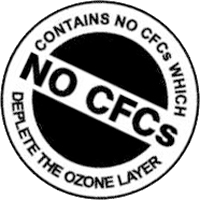
A very common label found on most aerosol cans nowadays
Image by Alondra Izamar Rodríguez Rodríguez under Creative Commons BY-SA 4.0 license via Wikimedia Commons
The problem is that these weapons of doubt are very effective on the easily impressionable and the uninformed. Especially right‑wing conservative individuals who think the government should never tell the people what to do. Among these we have Dixy Lee Ray, a zoologist, author, and (later on) a politician who had been listening to the CFC “debate” very closely, and who resonated very much with Singer’s ideas. Her most famous claim was that volcanoes produce more chlorine than CFCs… true… but the caveat here is that this excess chlorine from the volcanoes is measured through ash fall, which does not reach the stratosphere (like CFCs do). Rowland (Nobel prize guy) had shown this YEARS earlier. Besides the concentrations in the stratosphere had been steadily rising even in periods of low volcanic activity. Dixy Lee Ray (just like Singer) was full of shit! But that is what we get when doubt is planted: public confusion; a state that allows bullshit to spread like wildfire.
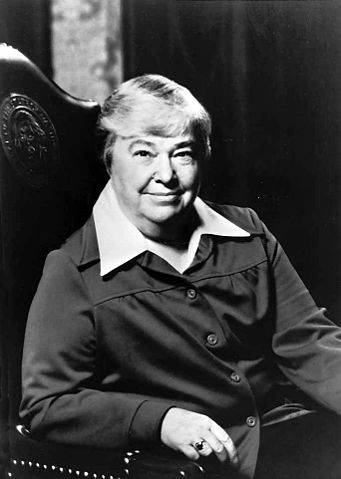
Dixie Lee Ray, Governor of Washington from 1977‑1981
Image under Public Domain via Wikimedia Commons
This stupid fight over regulation that had already passed, went all the way into the 1990s, and when Sherwood Rowland won the Nobel Prize in 1995. Fred fucking Singer attacked the Nobel committee. This guy was unstoppable!
But at this point we have to ask, why is Singer trying so hard to fight science?
Well, he answered the question himself when he said that “some of these ‘coercive utopians’ are socialists, some are technology‑hating Luddites; most have a great desire to regulate—on as large a scale as possible”. He also made it very clear that most of the environmentalist ideas were based on a “hidden political agenda” against “business, the free market, and the capitalistic system”. These claims would obviously resonate with his right wing (communophobe) readers like Dixy Lee Ray, and this dangerous message would echo through the conservative media outlets. By the mid 1990s environmentalism was coined a “green tree with red roots” and anti‑science articles were often published with titles like “Bad Climate in Ozone Debate”, “Ozone CFCs, and Science Fiction”, “The Dreaded Ozone Hole”, and “Nobel Politicized Award in Chemistry”... The demonization of science had begun…
Click on the next button to keep reading

